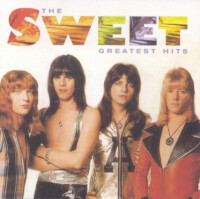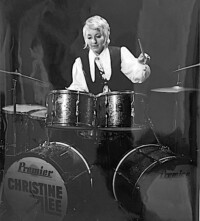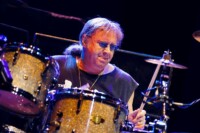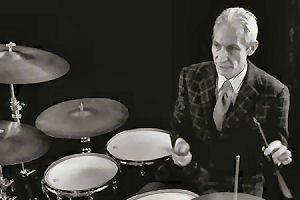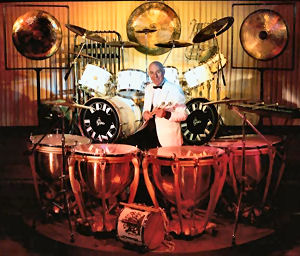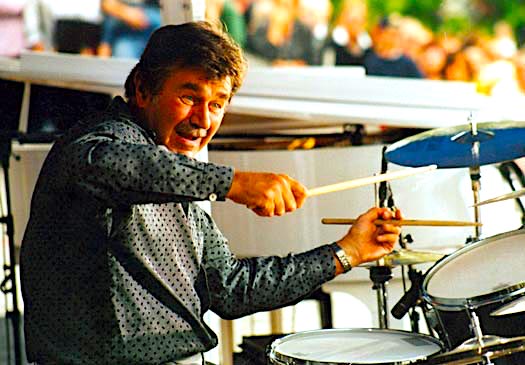 Pete York was born in Middlesbrough on the 15th of August 1942 and came to drumming from a slightly different angle to the rest of us ‘baby boomers’ in the UK. He played jazz first. I interviewed him once for Mike Dolbear when he was ‘snowed in’ in Germany and like all responsible Englishmen of our ilk we started our ‘in depth’ conversation by talking about the weather!
Pete York was born in Middlesbrough on the 15th of August 1942 and came to drumming from a slightly different angle to the rest of us ‘baby boomers’ in the UK. He played jazz first. I interviewed him once for Mike Dolbear when he was ‘snowed in’ in Germany and like all responsible Englishmen of our ilk we started our ‘in depth’ conversation by talking about the weather!
To begin at the beginning Pete got into drumming when he was roughly 8 years old. The York family evidently had one of those press-button brass bells that you find in a hotel reception and this was his first rudimentary percussion instrument. He’d ping along on it with a couple of pencils and accompany the music on the family’s radio.
This was 1950 and so he was listening to The Light programme to music from the likes of Billy Cotton and Jack Payne. That sort of thing which was what he called ‘lively’ music. He was aware of American jazz at that point and of course there wasn’t really any rock’n’roll as we came to know it.
At 10 years old he got a toy drum with short drumsticks, and set about driving his parents mad. Pete admits he had no idea what he was doing, just doing it for the fun of it.
By the time he was 12, he had saved up enough pocket money for a drum kit His parents evidently wouldn’t pay out for one. The first proper snare drum he had was 3 or 4” deep, had no name on it and cost him roughly £3. The York family was living in Nottingham and the drum came from a shop on the corner of what they call Theatre Square where the Theatre Royal and The Empire are situated.
In the ’50s Pete went to a boarding school where like many schools in the fifties, they did military training. He immediately joined the Army branch of the Combined Cadet Force band as a drummer where he was taught by the band master who was ex- Royal Marines. Here he learned the rudiments as far as singles, doubles and paradiddles were concerned. The other rudiments weren’t deemed to be really of any interest for the military. He started to learn those when he was about 13 – “This started me off on the things I was going to have to practise to play cleanly and so on.
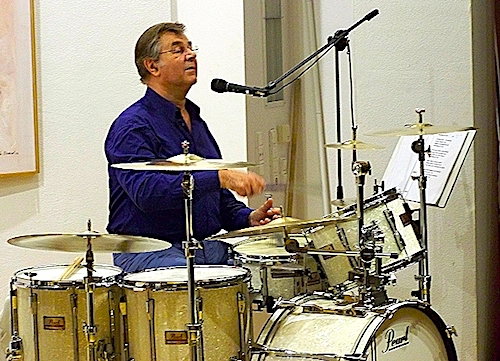 Before this he went to Nottingham High School but only for a short time. This was a day school and when he was 14 he became a ‘boarder’ at Trent College which is situated between Nottingham and Derby in a town called Long Eaton.
Before this he went to Nottingham High School but only for a short time. This was a day school and when he was 14 he became a ‘boarder’ at Trent College which is situated between Nottingham and Derby in a town called Long Eaton.
The school had a jazz club and Pete joined it. He was much taken by two films which came out in the middle ’50s which every aspiring drummer went to see: The Glenn Miller Story and The Benny Goodman Story. Gene Krupa was in both of them in glorious Technicolor. His short scenes made quite an impression on Pete. As he remembers it, the first life changing scene was in the Jazz Club where Krupa was playing with Louis Armstrong while James Stewart as Glenn Miller sat listening to him.
In The Benny Goodman Story, he had a bit more to do and even a couple of lines of dialogue. Pete told me it was great, absolutely wonderful. He was playing what he considered was jazz which was what he was into at that particular time.
He confided in me: “I think fairly early on I got the difference between what the Brits were playing in terms of jazz bearing in mind in ’54 or ’55 we had Chris Barber and all of them beginning to come up. There were big bands of course, I remember buying Ronnie Verrell’s version of Louie Bellson’s Skin Deep with Ken Macintosh when I was about 12 or so.”
He didn’t know what he wanted to do with his life. His dad was in the iron and steel business (no pun intended) and he thought he could help him if he went into that line. He had no idea what he wanted to do. He really wanted to be a musician but thought ‘forget it, that can’t happen’. So he knew he was going to have to work. His dad said he could put him in with this company in Birmingham, he’d do an apprenticeship there and have a good solid career. “That was all it was about in those days.” So Pete started to play semi professionally while starting the job at the same time.
“My first gigs were in Birmingham, I went there at age 18, started my apprenticeship and one of the people who I sat with in the office learning the things I had to learn, knew the sister of a jazz trumpeter who had come up from London to do a course at Birmingham University. He’d been a fairly successful jazz trumpeter on that student scene down in London according to this guy who’s sister knew him, and his name was Eddie Matthews.”
Eddie Matthews was a good player and he was looking for people to join his band. Pete went round to see him and introduced himself. They played together (with Pete playing his ram-shackle drum set which he describes as “a right old mix of stuff”) and he asked Pete to join him.
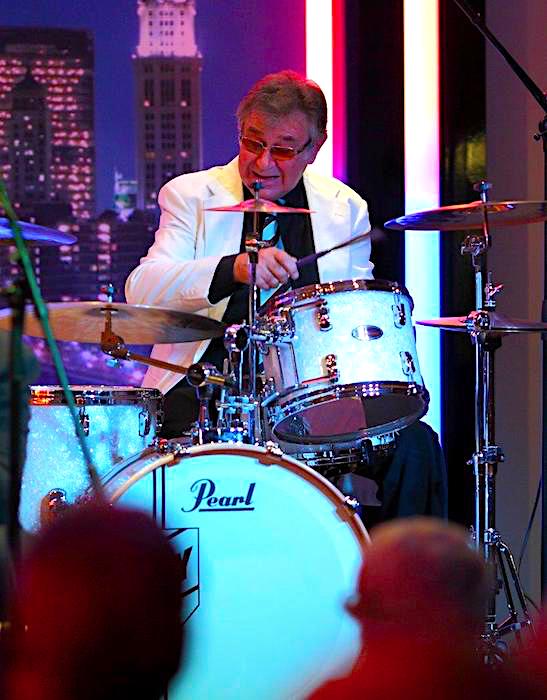 “We started as a quintet and at one point we had a septet as well. It was the quintet which was really quite good, and my influences at this time were of course the mainstream influences like the Basie Band. I’d seen Basie live in 1957 with Sonny Payne on the drums. A couple of years later Ellington came over and I saw Sam Woodyard. Small group people were really beginning to make an impression on us youngsters, like Cannonball Adderley, which was terrific stuff. I thought that was great. I could follow Charlie Parker’s lines and I thought what he was playing was absolutely terrific, but there were a lot of other people who got into playing great streams of notes where sometimes I thought those lines missed the point.”
“We started as a quintet and at one point we had a septet as well. It was the quintet which was really quite good, and my influences at this time were of course the mainstream influences like the Basie Band. I’d seen Basie live in 1957 with Sonny Payne on the drums. A couple of years later Ellington came over and I saw Sam Woodyard. Small group people were really beginning to make an impression on us youngsters, like Cannonball Adderley, which was terrific stuff. I thought that was great. I could follow Charlie Parker’s lines and I thought what he was playing was absolutely terrific, but there were a lot of other people who got into playing great streams of notes where sometimes I thought those lines missed the point.”
So to get to the point, Spencer Davis was at Birmingham University at this time and he used to sing during the intervals in the jazz session. He’d evidently come on with a 12-string guitar and a harmonica round his neck on a harness made out of a wire coat hanger and he’d do the sort of Donovan bit (although before Donovan). Then he would also sing a couple of songs with the band. The band was playing a traditional jazz number like ‘Shimmy Like My Sister Kate’ and ‘C.C. Rider’ and all those old blues things and he’d sing with Pete’s band which was how they got to know each other. In 1963 they won the National University Jazz Band Competition which got them on TV with the trophy.
Joe Morello had as big an impact on Pete as he had on the rest of us. He went to see him at a clinic at Digbeth Civic Hall, which was the headquarters of the Birmingham Jazz Club.
“From very early on I realised the Americans had a way of moving the sticks and sitting at the drums and playing which I wasn’t seeing too much of amongst my contemporaries. I was desperate to find out really how they did it, that American way of playing, it seemed so efficient for one thing.”
Pete was a Rogers endorser from early on and once had a rather special set which belonged to a famous endorser – Buddy Rich no less. In Pete’s own words: “Buddy started to come over in 1966 with the Big Band and knocked everybody sideways and at that point he was playing Rogers which I was also playing.
Buddy came over and did a clinic in Shaftesbury Avenue at the Dominion Theatre, but his American drums were on the road for the concerts. Of course at this time Rogers drums were also being made in England – they sent the parts over from America and built them here. So they made up a kit for him to his specs. He played this one clinic on that set and then it found its way back to Edgware because he was off on the road with his American Rogers. So I immediately jumped in to find out what was happening with that kit and was told “I don’t know what they’re going to do with it, sell it or something” so I said “Well can I have it?”
Pete was big at the time with Spencer Davis and Ken Spacey, who was in charge of things at Rogers drums in the UK, eventually agreed.
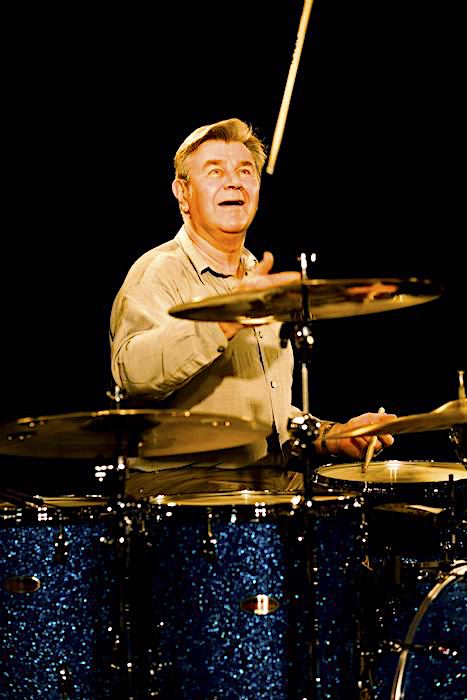 Pete actually had a kit of American-built Rogers which he bought from a drummer friend in Birmingham called Lionel Rubin who was on lunch time television almost every day. Lionel helped him as well – they’d meet in his shop, Ringway Music, and they’d talk about drum stuff and Lionel would help Pete with his technique.
Pete actually had a kit of American-built Rogers which he bought from a drummer friend in Birmingham called Lionel Rubin who was on lunch time television almost every day. Lionel helped him as well – they’d meet in his shop, Ringway Music, and they’d talk about drum stuff and Lionel would help Pete with his technique.
In 1970 (in what Pete describes as the glory days of clinic tours) Roy Burns came over as a staff clinician for Rogers to do a 3 weeks clinic tour around England. Pete mentioned to Ken Spacey (who was in charge of everything Rogers then), that he’d love to spend some time with Roy, and since he had a big car, and despite the fact he was playing with Spencer Davis with Muff and Steve Winwood, he volunteered to be his roadie. Pete didn’t want them to pay him anything, just provide a hotel room and Pete would drive him around and help him with the kit. He said he really wanted to be close to Roy Burns and see him up close. He’d seen him before and he played wonderfully in what Pete called a classical American way.
To step back a little, our paths first crossed in 1962 when Pete was doing semi-pro jazz gigs in Birmingham. He remembers his first pay was 15 shillings and a bottle of brown ale! So he did lots of jazz gigs for more brown ale around the Birmingham area which were of course a lot of fun. Then Spencer got this opportunity to put a band into a place called The Golden Eagle in Birmingham every Monday night and luckily the band he chose to go in with him was Pete, Muff and Steve. Steve played piano almost exclusively at that point as he’d done in his father’s jazz band but when he found Spencer’s guitar hanging around, he picked it up and of course within five minutes he could play it better than Spencer!
Pete said that he very much believed that Spencer never recovered from that. He found that he had a prodigy in his band who stole the thunder from him at every possible opportunity.
Spencer simply wanted to be a blues player at that time. Pete said: “Steve sang better than anybody and he just had it all naturally. He had this American thing going which he could do even with his fairly high voice then, we did a Big Band concert in Birmingham in 1964 with Johnny Patrick’s Big Band. We did those Ray Charles things and Steve sang them all and knocked everybody sideways, the maturity of his voice. Steve’s father was a dance band saxophone player but always around the house they had Coleman Hawkins and Ben Webster on the record player – so his sons were always hearing good stuff.”
Pete was completely immersed in jazz but somehow joined a hugely superior rock and roll band. His playing reflected his jazz roots and at the time the band didn’t mind,
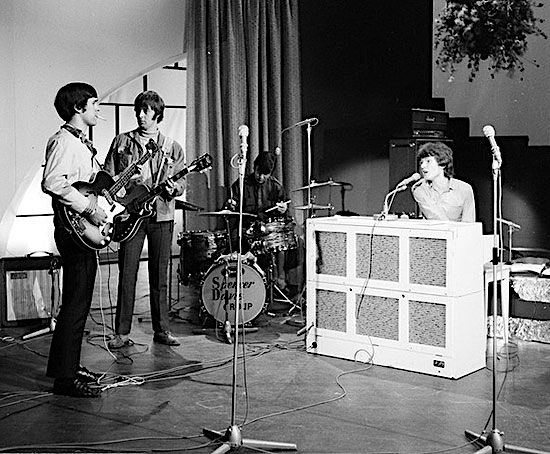 “Nobody at that point in the Spencer Davis Group, minded the fact that with Spencer the music had a swing to it. Even when we played straight 8s. A lot of rock players will play straight 8s and they’ll give all the 8 notes equal value, but I never did. You could phrase it a little differently which I always did. I didn’t really work this out thinking that’s what I’ll do; I just did it that way.”.
“Nobody at that point in the Spencer Davis Group, minded the fact that with Spencer the music had a swing to it. Even when we played straight 8s. A lot of rock players will play straight 8s and they’ll give all the 8 notes equal value, but I never did. You could phrase it a little differently which I always did. I didn’t really work this out thinking that’s what I’ll do; I just did it that way.”.
The Spencer Davis Group were successful almost from the word go. Their first record was “Dimples” in 1965, followed by “Keep On Running” ,“Somebody Help Me”, “Gimme Some Loving” were all in 1966. “I’m A Man” was released in 1967.
Some of these tracks had Pete playing fours on the bass drum which was a distinctly unfashionable thing to do in the days of ‘Rock a’shake’
The first Spencer Davis band eventually broke up and they brought in a couple of other people: Ray Fenwick and Eddie Hardin. Pete carried on with Spencer for about another year or so and made more singles, although by then the atmosphere inside the band was becoming strained. One thing that they did during Spencer’s shows at that time was Eddie and Pete’s feature number with just organ and drums. It was an arrangement they’d put together with a drum solo in it. The whole thing lasted about 10 minutes and it was evidently spectacular. This would have been about 1968, and they were doing this very successfully on their American tours. Eventually Pete decided he couldn’t take anymore and left. Eddie suddenly said that if Pete was going, he would too.
So Pete left Spencer Davis and kept going doing little jazz gigs, before forming ‘Hardin-York’ with Eddie aka ‘The World’s Smallest Big Band’. That duo worked very well and really hit it big in Germany and the three albums they made, with Mike Hurst producing, went gold.
Around this time Pete wrote the theme music for a children’s TV programme called ‘Magpie’.
Pete moved to Germany lock, stock and barrel in 1984 and he confessed he often used to ask himself what would have happened had he stayed in England – would he have been established on the scene here, would he have got into another big band? He really didn’t know. He could only say that since he moved over there he’s been very well treated and he’s done things like his ‘Super Drumming’ TV show which he feels could never have been done anywhere else. It’s something he’s justifiably proud of and absolutely a good thing to have done.
Other than what he learned in the Army cadets at school, Pete never went to drum lessons but, like many of our generation, taught himself to read music.
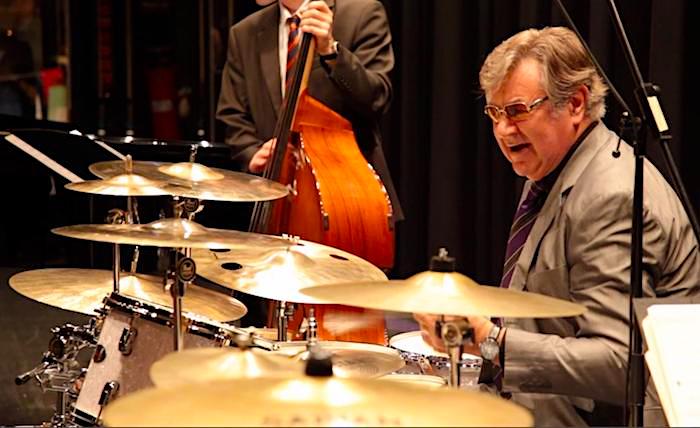 Regarding gear, Pete has played Pearl drums and Sabian cymbals for years but he started with the obligatory ‘Bitsa’’ kit.
Regarding gear, Pete has played Pearl drums and Sabian cymbals for years but he started with the obligatory ‘Bitsa’’ kit.
“But when I got to Birmingham and started going out doing proper gigs I had a Premier. Then I bought the American Rogers from Lionel Rubin. The set was from Cleveland and it had the silver paint on the inside of the shells, I don’t know what that was supposed to do.
“Then strangely enough the Rogers thing all went wrong somehow with Boosey and Hawkes, they started selling a kit made at the Premier factory under the name of Beverley. Ken Spacey who took over the Beverley marketing said to all of us who were endorsing Rogers “Right, we’ve got to have your Rogers stuff back again”, so we had to give it back, including the Buddy Rich kit. I should have bought it from them at the time but I didn’t think of it. Then these Beverley kits arrived. Me and Lenny Hastings played Beverley, Lenny was a great pal of mine, he had the American sound going on.”
Lenny was something of an unsung hero wasn’t he?
“Lenny was glorious. He could swing his arse off. I very much liked that small group thing in jazz, that Eddie Condon stuff. I liked George Wettling and Cliff Leeman, Dave Tough – tremendous. Lenny could do all that – none of the other trad drummers could.”
Pete was back playing Premier by the time he joined the Chris Barber band in 1978 to do a show called ‘Echoes of Ellington’. He hasn’t kept any of those iconic drums other than a Rogers snare drum from 1967, with a metal, ‘chrome over brass’ shell.
His next kit after that was in 1979 when he changed to Pearl where he’s remained since.
As far as Pete York’s present situation is concerned he has a great gig which he’s been doing for quite some time.
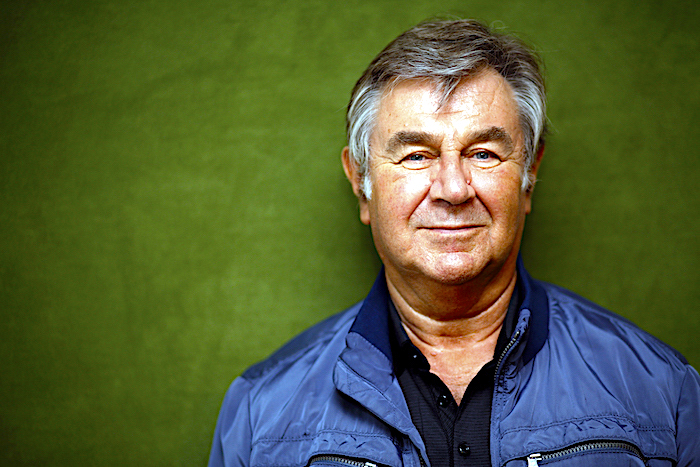 “What’s been a very good job for me now for several years is working with this German comedian, Helge Schneider. You can find lots of him on the internet, he’s very famous here in Germany. Sometimes we do 100 shows a year and he sells roughly 2000 tickets a night. He’s a great musician, he’s a natural player, he can play anything, very good trumpet, very good sax and he’s a super piano player, guitar, picks up anything.”
“What’s been a very good job for me now for several years is working with this German comedian, Helge Schneider. You can find lots of him on the internet, he’s very famous here in Germany. Sometimes we do 100 shows a year and he sells roughly 2000 tickets a night. He’s a great musician, he’s a natural player, he can play anything, very good trumpet, very good sax and he’s a super piano player, guitar, picks up anything.”
Pete feels he’s died and gone to heaven. He’s with a comedian who makes him laugh all night plus he gets to play nice music. He likes the kind of music Pete likes, so there’s lots of swing in it. He lets Pete do a big drum solo every night; and he gives him a great drum tech. Evidently his audience are all in their twenties.
Pete has made records and toured with more than his fair share of illustrious players who, for the sake of accuracy, I’ll try to list, and of course there are many fabulous drummers from his TV show days;
Louis Bellson, Simon Phillips, Ian Paice, Jon Hiseman, Nico McBrain, Zak Starkey, Steve Ferrone, Bill Bruford, Dave Mattacks, Trilok Gurtu, Cozy Powell, Mark Brzezicki, Billy Cobham, Jack Bruce, Trilok Gurtu, Charlie Watts, Chris Farlowe, Jon Lord, Colin Hodgkinson, Zoot Money, Brian Auger, Miller Anderson, Herman Rarebell, Charlie Antolini, Maria Muldaur, Dick Morrisey, Barbara Thompson, Ian Paice, Keef Hartley, Keith Moon, Roy Dyke and Chris Barber.
Pete York, right in the middle of a life well spent you might say!
Bob Henrit
January 2021

